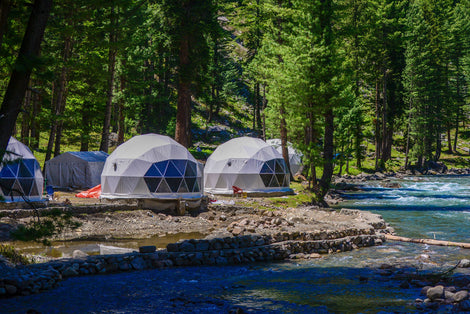How to Prevent Food Spoilage in Your Solar-Powered Refrigerator
When you're living off the grid, keeping your food fresh isn't just a convenience. It's something you count on every single day. A solar-powered refrigerator plays a big part in that, but if things go wrong, you can end up with spoiled meals and wasted groceries. That’s the kind of frustration no one wants, especially when energy is limited and trips to the store aren’t quick or easy.
Common problems range from uneven cooling to not realizing the battery bank didn’t hold enough power overnight. Maybe you've noticed dairy going bad faster than expected or veggies wilting before their time. These types of issues usually point back to how the fridge is set up or powered, or sometimes even how you're storing your food. The good news is that with the right habits and practices, you can avoid a lot of food waste and keep things running smoothly.
Optimize Your Sunstar Solar Refrigerator
Small choices in how you use your fridge off-grid can make a big difference. It starts with keeping it clean inside and out. A clean refrigerator runs more efficiently and doesn’t have to work as hard, which helps preserve your food longer. Leftover spills or crumbs can block air vents or lead to smells that linger. Make a quick wipe-down part of your weekly routine so nothing builds up over time.
Temperature matters too. If the fridge runs too warm, your food won't stay cold enough. If it runs too cold, items can freeze that shouldn’t. Aim to keep the fridge space around 37°F and the freezer around 0°F. If your fridge has a dial instead of a digital setting, you might need to check it with a fridge thermometer every now and then to be sure. Watch for temperature swings, especially after multiple door openings in a short time.
How you arrange your food makes a big difference. Here are a few things to keep in mind:
- Don’t stuff the fridge. You need airflow around all your items for even cooling.
- Allow space between items. Pushing containers close together stops cold air from circulating.
- Put quicker-to-spoil items in the center or middle shelf where conditions stay the most stable.
- Avoid blocking air vents. That’s where most of the cold air comes in and should stay clear.
- Store taller jugs and bottles toward the door or sides, not directly in the middle of a shelf.
One good tip is to keep a few water bottles filled and chilled in the fridge section. They hold cold air longer and help keep the internal temperature steadier when power dips during the night. It’s a simple buffer but works well, especially during hotter months.
Energy Management for Off-Grid Cooling
A solar fridge is only as good as the power behind it. If the battery bank gets drained or doesn’t charge well throughout the day, your fridge won’t last through the night. That’s often when spoilage starts. The first step is checking whether your panels are collecting enough sun during peak hours and whether anything is blocking them like dust, leaves, or shifting shadows. Clean panels power your system better.
The next part to watch is how your refrigerator uses energy compared to how much your system stores. If it’s running more than it's charging, you’ll be in a power deficit. That gets worse with cloudy days or short charging windows as seasons change. Having the right size battery storage, well-matched to the fridge’s energy draw, is key to keeping it consistent through the night.
Tracking daily usage helps you catch problems before they mess with your food. Pay attention to signs like the fridge light dimming, the compressor running longer than normal, or the battery monitor dropping to single digits well before morning. Any of those could point to a power shortage.
There are also a few simple habits that help stretch your energy further during the day:
1. Limit how often the door gets opened. Each time it’s opened, cold air escapes and power is used up fast.
2. Don’t overload it with warm leftovers right after cooking. Let food cool first before placing it inside.
3. Keep the fridge in a shaded, ventilated space indoors. Avoid garages or sunrooms where heat builds up.
4. Schedule your fridge to run heavier during daylight hours, when your panels are at their strongest.
5. Use a temperature alarm or energy monitor that alerts you to major dips before food is impacted.
Think of energy use like filling a bucket with solar during the day. Everything you do to keep that bucket from leaking helps ensure the fridge stays cold overnight. When the setup is balanced, you don’t have to worry about opening the fridge in the morning and finding wilted greens or sour milk.
Food Storage Tips for Solar Refrigeration
No matter how well your solar fridge is set up, the way food is stored inside it can either help or hurt how long it stays fresh. It’s not just about keeping things cold. It’s also about how you seal, stack, and rotate what you store. Small changes in this area go a long way when you don’t have the luxury of tossing out spoiled groceries every few days.
Start with using airtight containers. These help lock in moisture for fruits, veggies, and leftovers while keeping out strong food smells that can spread through the rest of the fridge. They also prevent leaks and spills, which are harder to clean and can lead to cross-contamination.
Then you’ve got to think about food type and placement. Raw meat and fish should always be stored on the bottom shelf. If anything drips, it won’t run onto other food. Keep dairy items upright near the center where the temperature remains stable. Leftovers and ready-to-eat items can go up top for easy access and less handling.
To stay ahead of spoilage, try these food storage tips:
- Use clear containers so you can see what’s inside without opening everything
- Label each item with the date it was made or bought
- Practice “first in, first out”—older items should be used before newer ones
- Separate strong-smelling foods like onions or garlic in sealed pouches
- Avoid stacking warm food. Let it cool before putting it in the fridge to keep internal temps steady
- Store fruits and vegetables in bins labeled by type and keep damp paper towels inside to help with moisture control
Think through simple setups that maximize shelf space. One family we worked with in a remote cabin switched to stackable square containers and reported their fridge ran longer without noticeable cold spots or warm zones. The key is to build a rhythm of storage that makes it easy to rotate, spot-check, and handle items before they become risky to eat.
Set a Routine for Maintenance Checks
Even if everything looks fine on the outside, performance can still taper off inside your Sunstar solar refrigerator. Setting a maintenance routine helps prevent issues before they start to affect your food. Skipping these steps, even for just a month or two, could mean your fridge works harder and still doesn’t stay cool enough.
Start with the basics. Clean the condenser coils if you can access them. Dust builds up and insulates the coils, which keeps heat from escaping. When heat gets trapped, the internal cooling slows down. Wiping the coils every two to three months can help with this, especially if your setup is inside a cabin where dust and pet hair tend to collect.
Check the door seals too. Close a dollar bill in the door. If it slips out easily, your seal may be worn. A weak seal lets warm air in and cold air out all day long, which cuts into efficiency and forces the fridge to run longer than it should. If you notice frost on your food or water pooling inside, this could be the problem.
Don’t forget the solar panels themselves. Clear off any dirt, bird droppings, or pollen build-up with a gentle cloth and water. Skip the soap. Cleaner surfaces mean better sunlight absorption and more power available to your fridge. Do this at the start and middle of each season.
Maintenance should also include a quick systems check on your battery bank and charge controller. Look over wiring for frays, loose connectors, or signs of overheating. If things aren’t holding or transferring power like usual, none of the tips in this article will matter. It all starts with dependable energy.
Keeping Food Fresh Off-Grid
Living off solar isn’t about perfection. It’s about steadiness. And when it comes to your refrigerator, steadiness shows up in how you manage energy, airflow, food placement, and regular upkeep. Skipping any of these can lead to food spoiling sooner than it should, which brings frustration and waste.
By keeping the inside of your fridge clean, learning energy-saving habits, storing food smartly, and staying on top of small maintenance tasks, you give your system the best chance to run well through each season. It doesn’t take fancy gear, just some thought, a little time, and paying attention to how your fridge responds to day-to-day use.
When you're off-grid, you learn to trust your setup because you've put in the work to get it right. A well-run solar-powered refrigerator is quiet, efficient, and barely noticeable during everyday life, which is exactly how it should be when your goal is to live simply and stay independent.
To maximize the efficiency of your setup and safeguard your food supply off-grid, consider integrating a comprehensive solar kit into your energy plan. With the right kit, like the options available for a Sunstar solar refrigerator from Green Vista Living, you can ensure your fridge is well-supported by reliable solar power. Our solar kits help maintain consistent cooling and reduce the risk of food spoilage even in remote locations.







